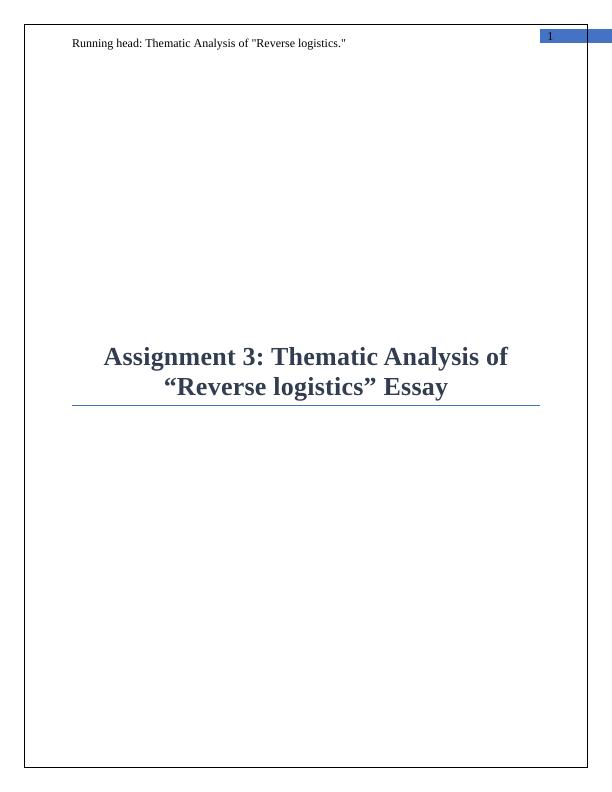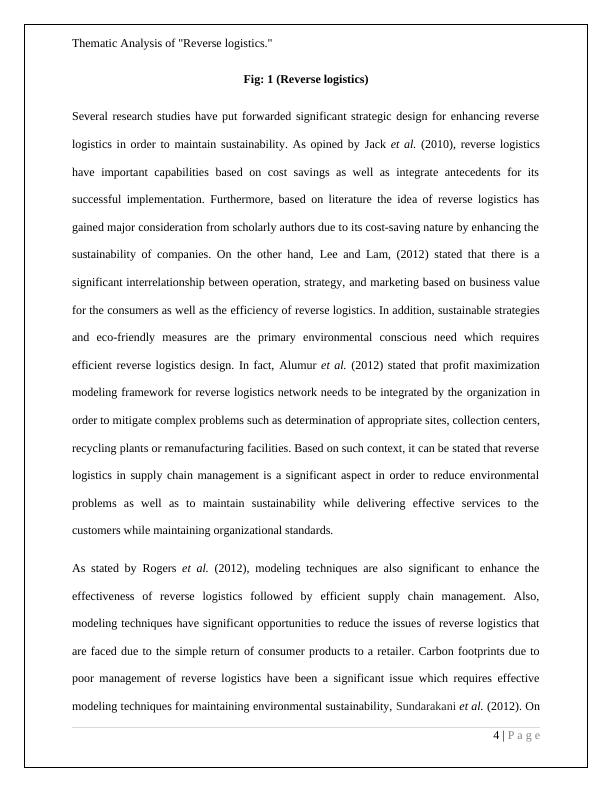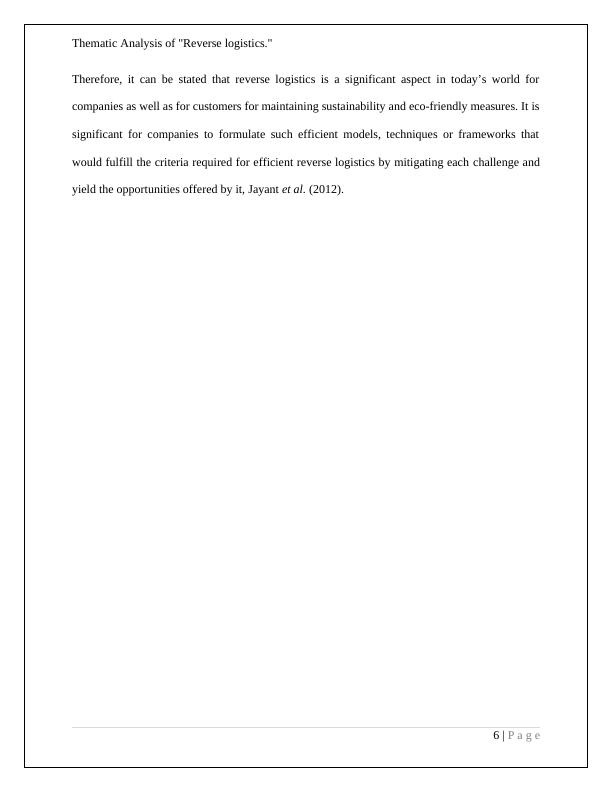Thematic Analysis of Reverse Logistics in Supply Chain Management
Added on 2023-06-10
26 Pages4690 Words474 Views
1
Running head: Thematic Analysis of "Reverse logistics."
Assignment 3: Thematic Analysis of
“Reverse logistics” Essay
Running head: Thematic Analysis of "Reverse logistics."
Assignment 3: Thematic Analysis of
“Reverse logistics” Essay

Thematic Analysis of "Reverse logistics."
Table of Contents
Essay................................................................................................................................................3
Thematic analysis............................................................................................................................7
References......................................................................................................................................16
Appendix........................................................................................................................................18
Thematic table...........................................................................................................................18
2 | P a g e
Table of Contents
Essay................................................................................................................................................3
Thematic analysis............................................................................................................................7
References......................................................................................................................................16
Appendix........................................................................................................................................18
Thematic table...........................................................................................................................18
2 | P a g e

Thematic Analysis of "Reverse logistics."
Essay
Reverse logistics in the supply chain has been an essential part to monitor the life-cycle of the
products after the arrival of the product to end consumer. In addition, it would significantly
integrate the creation of product value after its expiry through reusing or appropriate disposal of
the product after being used. As put forwarded by Sarkis et al. (2010), reverse supply chain
logistics’ strategic application could enhance the reclamation of the products that have ended
their significant life. Furthermore, the impact on the environment has to be a significant concern
for organizations based on recycling, reclamation, and reuse in order to save costs, landfill space,
and fuel. Reverse logistics integrates physical shipping of the returned product, quality testing in
order to identify flaws, documentation of any issues and lastly restocking, dissembling, recycling
or repairing of the returned product. As stated by Salema et al. (2010), the responsibilities of
good producers have increased due to societal awareness which requires effective integration of
reverse logistics. In addition, at present times the competent framework and operation of supply
chains based on return flows have been a serious concern for several organizations.
3 | P a g e
Essay
Reverse logistics in the supply chain has been an essential part to monitor the life-cycle of the
products after the arrival of the product to end consumer. In addition, it would significantly
integrate the creation of product value after its expiry through reusing or appropriate disposal of
the product after being used. As put forwarded by Sarkis et al. (2010), reverse supply chain
logistics’ strategic application could enhance the reclamation of the products that have ended
their significant life. Furthermore, the impact on the environment has to be a significant concern
for organizations based on recycling, reclamation, and reuse in order to save costs, landfill space,
and fuel. Reverse logistics integrates physical shipping of the returned product, quality testing in
order to identify flaws, documentation of any issues and lastly restocking, dissembling, recycling
or repairing of the returned product. As stated by Salema et al. (2010), the responsibilities of
good producers have increased due to societal awareness which requires effective integration of
reverse logistics. In addition, at present times the competent framework and operation of supply
chains based on return flows have been a serious concern for several organizations.
3 | P a g e

Thematic Analysis of "Reverse logistics."
Fig: 1 (Reverse logistics)
Several research studies have put forwarded significant strategic design for enhancing reverse
logistics in order to maintain sustainability. As opined by Jack et al. (2010), reverse logistics
have important capabilities based on cost savings as well as integrate antecedents for its
successful implementation. Furthermore, based on literature the idea of reverse logistics has
gained major consideration from scholarly authors due to its cost-saving nature by enhancing the
sustainability of companies. On the other hand, Lee and Lam, (2012) stated that there is a
significant interrelationship between operation, strategy, and marketing based on business value
for the consumers as well as the efficiency of reverse logistics. In addition, sustainable strategies
and eco-friendly measures are the primary environmental conscious need which requires
efficient reverse logistics design. In fact, Alumur et al. (2012) stated that profit maximization
modeling framework for reverse logistics network needs to be integrated by the organization in
order to mitigate complex problems such as determination of appropriate sites, collection centers,
recycling plants or remanufacturing facilities. Based on such context, it can be stated that reverse
logistics in supply chain management is a significant aspect in order to reduce environmental
problems as well as to maintain sustainability while delivering effective services to the
customers while maintaining organizational standards.
As stated by Rogers et al. (2012), modeling techniques are also significant to enhance the
effectiveness of reverse logistics followed by efficient supply chain management. Also,
modeling techniques have significant opportunities to reduce the issues of reverse logistics that
are faced due to the simple return of consumer products to a retailer. Carbon footprints due to
poor management of reverse logistics have been a significant issue which requires effective
modeling techniques for maintaining environmental sustainability, Sundarakani et al. (2012). On
4 | P a g e
Fig: 1 (Reverse logistics)
Several research studies have put forwarded significant strategic design for enhancing reverse
logistics in order to maintain sustainability. As opined by Jack et al. (2010), reverse logistics
have important capabilities based on cost savings as well as integrate antecedents for its
successful implementation. Furthermore, based on literature the idea of reverse logistics has
gained major consideration from scholarly authors due to its cost-saving nature by enhancing the
sustainability of companies. On the other hand, Lee and Lam, (2012) stated that there is a
significant interrelationship between operation, strategy, and marketing based on business value
for the consumers as well as the efficiency of reverse logistics. In addition, sustainable strategies
and eco-friendly measures are the primary environmental conscious need which requires
efficient reverse logistics design. In fact, Alumur et al. (2012) stated that profit maximization
modeling framework for reverse logistics network needs to be integrated by the organization in
order to mitigate complex problems such as determination of appropriate sites, collection centers,
recycling plants or remanufacturing facilities. Based on such context, it can be stated that reverse
logistics in supply chain management is a significant aspect in order to reduce environmental
problems as well as to maintain sustainability while delivering effective services to the
customers while maintaining organizational standards.
As stated by Rogers et al. (2012), modeling techniques are also significant to enhance the
effectiveness of reverse logistics followed by efficient supply chain management. Also,
modeling techniques have significant opportunities to reduce the issues of reverse logistics that
are faced due to the simple return of consumer products to a retailer. Carbon footprints due to
poor management of reverse logistics have been a significant issue which requires effective
modeling techniques for maintaining environmental sustainability, Sundarakani et al. (2012). On
4 | P a g e

Thematic Analysis of "Reverse logistics."
the other hand, Akdoğan and Coşkun, (2012) suggested that there are significant drivers of
reverse logistics in order to maintain a sustainable environment by companies. In addition,
pressure from both consumers and government to attain efficient framework for reverse logistics
has been critical for manufacturers. A survey performed on Hong Kong businesses by Ho et al.
(2012), provided significant evidence that human resource and financial factors are essential
factors that influence the execution of reverse logistics in organizations. In addition, tangible
resources do not have much influence. In contrary Li and Tee, (2012), stated that each
influencing factors integrating formal and informal waste sectors need to be considered for
efficient reverse logistics model.
Furthermore, tangible factors also influence the implementation of reverse logistics and impacts
health, economy, and environment. A survey conducted on Malaysian E&E companies by Khor
and Udin, (2012), highlighted the after-effect of reverse logistics product disposition towards
business performance. It is significant to consider restoration of both parts and products practical
traits in order to yield recyclables or reuse the product as energy resources which can maximize
profit. In addition, Hazen et al. (2012) confirmed that companies that adopt green or sustainable
reverse logistics offer huge customer satisfaction that increases loyalty towards the firm and
increase the purchase of the products. The combination of distribution planning and strategic
production of the supply chain can significantly lead to better design of reverse logistics as well
as planning, Das, (2012). In contrary, a survey conducted on Chinese firms based on reverse
logistics by Abdulrahman et al. (2014) forecasted that there are key difficulties to reverse
logistics including lack of logistics experts in the management, financial instability, lack of
systems for return monitoring as well as government laws and economic policies.
5 | P a g e
the other hand, Akdoğan and Coşkun, (2012) suggested that there are significant drivers of
reverse logistics in order to maintain a sustainable environment by companies. In addition,
pressure from both consumers and government to attain efficient framework for reverse logistics
has been critical for manufacturers. A survey performed on Hong Kong businesses by Ho et al.
(2012), provided significant evidence that human resource and financial factors are essential
factors that influence the execution of reverse logistics in organizations. In addition, tangible
resources do not have much influence. In contrary Li and Tee, (2012), stated that each
influencing factors integrating formal and informal waste sectors need to be considered for
efficient reverse logistics model.
Furthermore, tangible factors also influence the implementation of reverse logistics and impacts
health, economy, and environment. A survey conducted on Malaysian E&E companies by Khor
and Udin, (2012), highlighted the after-effect of reverse logistics product disposition towards
business performance. It is significant to consider restoration of both parts and products practical
traits in order to yield recyclables or reuse the product as energy resources which can maximize
profit. In addition, Hazen et al. (2012) confirmed that companies that adopt green or sustainable
reverse logistics offer huge customer satisfaction that increases loyalty towards the firm and
increase the purchase of the products. The combination of distribution planning and strategic
production of the supply chain can significantly lead to better design of reverse logistics as well
as planning, Das, (2012). In contrary, a survey conducted on Chinese firms based on reverse
logistics by Abdulrahman et al. (2014) forecasted that there are key difficulties to reverse
logistics including lack of logistics experts in the management, financial instability, lack of
systems for return monitoring as well as government laws and economic policies.
5 | P a g e

Thematic Analysis of "Reverse logistics."
Therefore, it can be stated that reverse logistics is a significant aspect in today’s world for
companies as well as for customers for maintaining sustainability and eco-friendly measures. It is
significant for companies to formulate such efficient models, techniques or frameworks that
would fulfill the criteria required for efficient reverse logistics by mitigating each challenge and
yield the opportunities offered by it, Jayant et al. (2012).
6 | P a g e
Therefore, it can be stated that reverse logistics is a significant aspect in today’s world for
companies as well as for customers for maintaining sustainability and eco-friendly measures. It is
significant for companies to formulate such efficient models, techniques or frameworks that
would fulfill the criteria required for efficient reverse logistics by mitigating each challenge and
yield the opportunities offered by it, Jayant et al. (2012).
6 | P a g e

End of preview
Want to access all the pages? Upload your documents or become a member.
Related Documents
Advanced Supply Chain Management Report 2022lg...
|15
|4598
|53
A Review of Decision-Support Tools and Performance Measurement for Sustainable Supply Chain Managementlg...
|23
|15595
|33
Integrated Business Management Projectlg...
|9
|2040
|355
Strategic Supply Chain and Logistics Managementlg...
|12
|664
|13
Supply Chain Sustainability in Dell - Assignmentlg...
|11
|2579
|143
Green Supply Chain Management: Strategies and Practiceslg...
|21
|4857
|384
